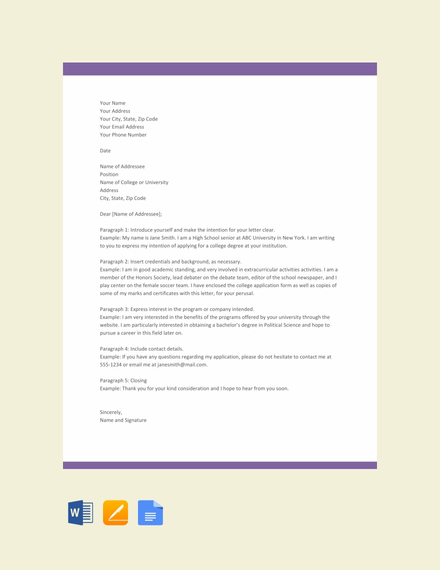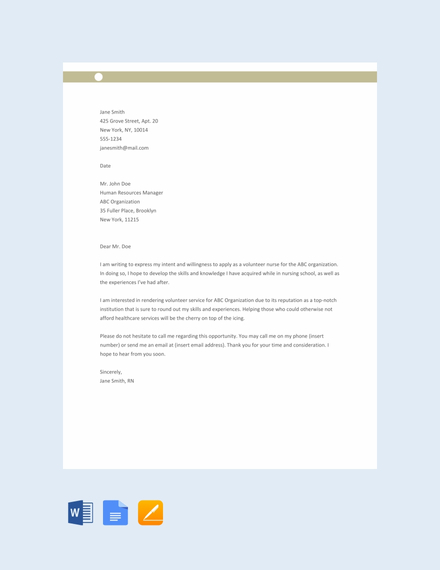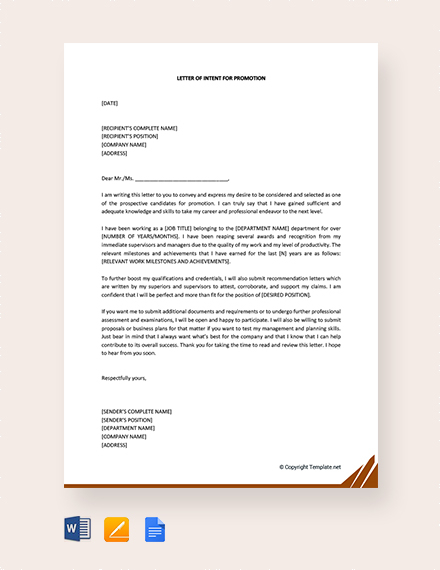Letter of Intent

Before a formal agreement, individuals tend to reach out to their target by other means. Nowadays, people do it through online means, with email being a popular method. However, to make it more personal, a letter of intent is usually sent before anything else. The use of this letter is crucial, especially in a lot of professional settings.
What is a Letter of Intent?
A Letter of Intent (LOI) is a formal document used to express an individual’s interest in a specific opportunity, position, or agreement. It serves as a preliminary agreement between two parties before finalizing a formal contract and outlines the main points of the deal or position being considered. In the context of employment, such as for a teaching position, a Letter of Intent is used by a job applicant to convey their interest in a job opening, highlighting their qualifications, experience, and reasons for wanting to join the organization.

How to write a letter of intent?
An LOI should clearly outline your intentions, interest, and what you bring to the table. Here’s a step-by-step guide on how to write an effective letter of intent:
Heading
- Your Name
- Your Address
- City, State, Zip Code
- Email Address
- Phone Number
- Date
- Recipient’s Name (if known)
- Title
- Organization’s Name
- Address
- City, State, Zip Code
Salutation
- If you know the recipient’s name, use “Dear [Name]:”
- If you don’t know the recipient’s name, use “Dear Hiring Manager:” or “To Whom It May Concern:”
Introduction
- State the purpose of your letter clearly. Mention the position, opportunity, or program you are applying for.
- Briefly introduce yourself, highlighting your current role or relevant background.
Body
- Express your interest in the opportunity and the organization or program. Explain why you are a good fit.
- Detail your relevant experience and skills. Provide specific examples that demonstrate your abilities and how they align with the goals of the position or program.
- Explain what you hope to achieve by taking this opportunity. Discuss how it fits into your career or academic goals.
- Conclusion
- Reiterate your interest and enthusiasm for the opportunity.
- State your availability for interviews or further discussion.
- Thank the recipient for considering your application.
Closing
- Use a professional closing, such as “Sincerely,” followed by your name.
35+ Letter of Intent Samples
20+ Letter of Intent Templets & Examples
Letter of Intent Template

Letter of Intent Acquisition of Business Example

Restaurant Letter of Intent Example

Restaurant Non-Binding Letter of Intent Example

Restaurant Letter of Intent for Transaction Example

Letter of Intent Format

Letter of Intent Example

Free Letter of Intent for Promotion

Letter of Intent for Job Application Template

Template Details
Letter of Intent for Job Opening Template

Free Letter of Intent for Promotion of Teacher

Letter of Intent for Job within Same Company

Letter of Intent to Continue Service

Letter of Intent to Lease Template

Letter of Intent to Purchase Equipment

Letter of Intent to Purchase Goods Template

Letter of Intent to Purchase Land

Pilot Project with Letter of Intent

Letter of Intent Sample

Embassy of Ghana’s Letter of Intent

Sample Letter of Intent

Commercial Lease Letter of Intent

How Does a Letter of Intent Differ From a Cover Letter?
The distinction between a Letter of Intent (LOI) and a Cover Letter is crucial for job seekers and students aiming for academic or career opportunities. Though both documents serve as introductory communications, highlighting your qualifications and interest in a position or program, they differ in purpose, content, and context.
Purpose
- Letter of Intent (LOI): An LOI is often used in academic and business transactions. In academia, it’s typically submitted with scholarship, college, or university applications, indicating the applicant’s intentions to enroll in a program. In business, it might be used to propose a deal or signal the intent to purchase or merge with another company.
- Cover Letter: A cover letter is specifically job-related. It accompanies a resume when applying for employment, detailing the applicant’s interest in the job and qualifications that make them the ideal candidate.
Content
- Letter of Intent (LOI): An LOI tends to be more comprehensive, covering a range of intentions, plans, and interests. For academic LOIs, it might discuss the applicant’s academic goals, research interests, or reasons for choosing a particular program. In business, it outlines the terms of a proposed agreement.
- Cover Letter: A cover letter is tailored to a specific job listing. It highlights relevant skills and experiences, demonstrates knowledge of the company, and explains why the applicant is a good fit for the position.
Context
- Letter of Intent (LOI): The use of an LOI is broader and more versatile, applicable in various scenarios beyond job applications. It’s about indicating intentions or interest in a particular course of action, be it academic enrollment, business deals, or specific projects.
- Cover Letter: The context for a cover letter is strictly professional employment. It is a personal sales pitch aiming to convince the employer that the applicant is the right person for the job.
Why Do Companies Ask for Letters of Intent?
Companies request Letters of Intent (LOI) for various reasons, spanning from employment processes to business transactions. An LOI serves as a preliminary agreement between two parties before finalizing a formal contract. It outlines the terms of a deal or the intention to engage in business together, offering several benefits to both requesting companies and the individuals or entities responding to these requests.
Clarification of Intentions
- Outline Preliminary Agreements: An LOI helps in setting the groundwork for any agreement or negotiation, clearly stating the intentions and expectations of both parties. This early clarity can prevent misunderstandings and streamline the negotiation process.
Assessment of Interest and Commitment
- Gauge Commitment: By asking for an LOI, a company can assess the seriousness and commitment level of the candidate or the other party involved in a business deal. It’s a way to ensure that both parties are genuinely interested in moving forward.
Risk Mitigation
- Reduce Uncertainty: An LOI helps in reducing the risks associated with investments, partnerships, or employment by providing a written document that outlines the key terms and conditions agreed upon preliminarily.
Resource Allocation
- Effective Resource Planning: Understanding the intentions and level of interest from potential candidates, partners, or buyers allows companies to allocate their resources more efficiently, focusing on the most promising opportunities.
Legal Protection
- Legal Framework: While not always legally binding in terms of the specifics of the deal, certain elements of an LOI, like confidentiality clauses, can offer legal protection to the parties involved.
Facilitation of Negotiations
- Eases Negotiation Process: An LOI serves as a foundation for detailed negotiations, making it easier for both parties to discuss terms and conditions based on a mutually agreed preliminary framework.
Enhancement of Transaction Speed
- Speeds Up the Process: By agreeing on the main points early and documenting them in an LOI, companies can expedite the negotiation and contract finalization process.
How to Draft a Letter of Intent
Since a letter of intent involves essential business transactions, it is vital to take meticulous care when creating it. There are a few essential elements that writers should make sure when putting together a letter of intent.
1. Make the Summary Statement
To make your summary statement think about these questions. Who wants to do what? How much is requested? Is this a portion of a more considerable project cost? The answers should be able to stand on its own, and if the reviewer reads nothing else, they should know what you want to do from reading this paragraph.
2. Write the Reason For This Letter
Write about the issue that you want to address in your letter of intent. Explain why you have chosen to respond to this set of points in the way that you have. For example, if you are a student seeking to transfer to another university, then indicate your reasons for the letter of intent.
3. Share Your Credentials
Whether this is for a job application or a business proposal, add them to your letter of intent’s content. Sharing your credentials will give your message a strong impression to your reader and convince them to reach out to you a lot sooner. Brag with substance by indicating awards, rankings, and tangible measures that set you apart from your peers.
4. Make a Strong Closing
Offer any additional information the reader might need, including a contact name and contact information. Express appreciation for the reader’s attention or the opportunity if it is in response to them.
FAQ’s
How Serious is a Letter of Intent?
A Letter of Intent (LOI) is quite serious as it reflects a commitment to proceed with negotiations or a transaction. It outlines preliminary agreements and intentions, laying the groundwork for formal contracts.
Is a Letter of Intent Worth Anything?
Yes, a Letter of Intent holds significant value. It demonstrates mutual interest and commitment to move forward, serving as a foundational document for further negotiations and planning.
Does Letter of Intent Mean Offer Letter?
No, a Letter of Intent is not the same as an offer letter. An LOI indicates a general commitment to a deal or negotiation, while an offer letter is a formal job proposal outlining specific terms of employment.
Is it possible for a Letter of Intent be legally binding?
Parties involved may want the letter of intent be a legally binding contract. However, details of most transactions usually are not discussed until the drafting of a full agreement, which means that the parties should be careful. It is better than legally binding letters of intent only to be used if necessary.
Is there a time limit for a letter of intent?
Yes, a letter of intent usually takes around 72 to 96 hours for it to be valid in its use. This is typically a rule in a business or school setting when it comes to matters of job applications or scholarships.
Can I change my mind after I signed a letter of intent?
Only if it is legally binding, letter of intent is usually informal, however. But if it is not the case, it is possible to appeal for your release from its clause. You must do this, especially if you are in a professional setting, so that it is all sorted out properly.
According to an article by Forbes, the drafting of a letter of intent is essential. It sets out the terms in black and white, cuts off futile negotiations, helps a deal move forward, and reduces legal fees. That is why you must be meticulous when making your own. With a well-written letter of intent, you will have an easy time getting things started. Keep that in mind the next time you are going to make one.

























